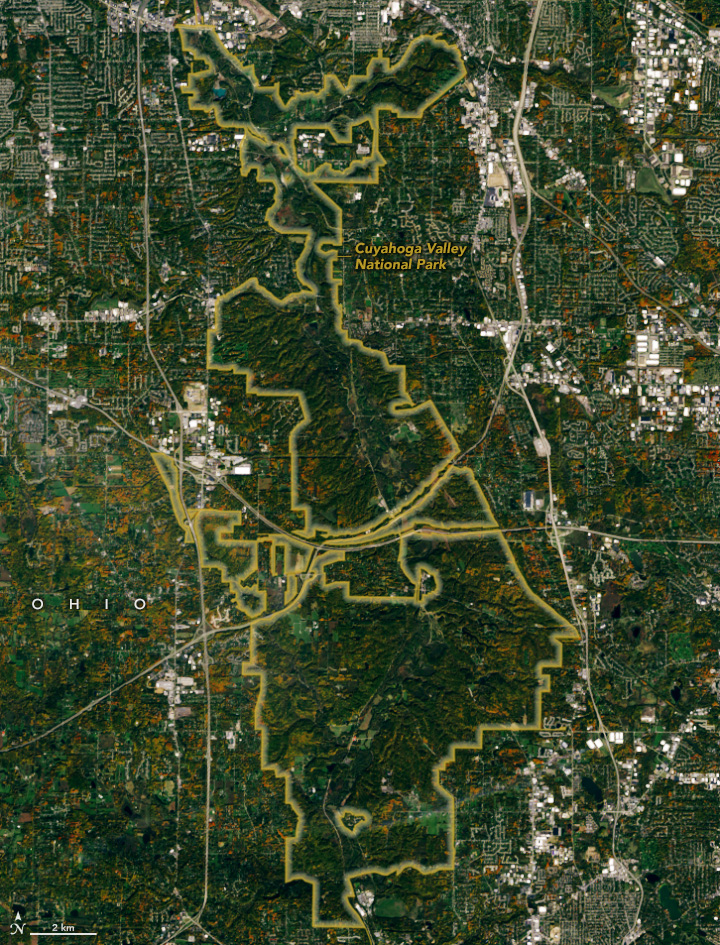
Fall Color in the Cuyahoga Valley
Downloads
- cuyahogafallzm_oli2_2023296_lrg.jpg (902x601, JPEG)
- cuyahogafall_oli2_2023296_lrg.jpg (958x1257, JPEG)
Metadata
- Sensor(s):
- Landsat 9 - OLI-2
- Data Date: October 23, 2023
- Visualization Date: November 3, 2023
Between the Rust Belt cities of Cleveland and Akron, Ohio, deciduous forests put on a coppery fall display in the Cuyahoga Valley. The OLI-2 (Operational Land Imager-2) on Landsat 9 captured this autumnal image on October 23, 2023, around the time colors typically reach their peak in and around Cuyahoga Valley National Park.
Broadleaf trees, such as red and silver maples, white and northern red oaks, and bigtooth aspen, fill the forests of the Cuyahoga Valley. Their leaves turn shades of red and yellow as they lose chlorophyll, the molecule that plants use to synthesize food and makes leaves appear green. When daylight hours shorten and temperatures fall, chlorophyll concentrations also drop, offering a chance for other leaf pigments—particularly carotenoids and anthocyanins—to show off their colors.
The Cuyahoga River flows north through this scene on its crooked path to Lake Erie. Approximately 22 miles (35 kilometers) of the river and the rich ecological, cultural, and historical resources flanking it make up Cuyahoga Valley National Park (below). The land was first designated the Cuyahoga Valley National Recreation Area in 1974 to protect undeveloped land between industrial cities. It became a national park in 2000 and consistently ranks as one of the top 10 most visited national parks in the United States. Popular park attractions include Brandywine Falls and the Towpath Trail, the path that mules once used to pull boats along the Ohio & Erie Canal.
The river is infamous for its history of pollution; oil slicks on the water caught fire on multiple occasions dating back to 1868. A fire in 1969 burned for only about 30 minutes but had a long-lasting legacy, as it helped to inspire the first Earth Day and the establishment of the Environmental Protection Agency (EPA). Today, much of the river’s watershed remains an Area of Concern under the EPA’s Great Lakes Water Quality Agreement. Water quality is improving overall, and work continues to reduce urban stormwater runoff, restore floodplain and wetland habitat, and remove dams.
Changes in land use and restored landscapes are hallmarks of the valley. Much of its forests contain secondary growth where trees had been cleared to establish farms a century ago. Charismatic species such as bald eagles have returned to the habitat, although threats remain from invasive species, plant disease, and an overabundance of deer browsing on seedlings and ground-cover plants. Other changes include the Superfund cleanup of the Krejci Dump—a hazardous waste disposal facility transformed into a wetland—and the restoration of the Richfield Coliseum property, now a 327-acre grassland growing where a professional basketball arena once stood.
References
- Encyclopedia of Cleveland History Cuyahoga Valley National Park. Case Western Reserve University. Accessed November 3, 2023.
- Environmental Protection Agency (2023) Cuyahoga River Area of Concern. Accessed November 3, 2023.
- National Park Service (2023) Cuyahoga Valley National Park. Accessed November 3, 2023.
- National Park Service (2013) Cuyahoga Valley National Park Foundation Document. Accessed November 3, 2023.
- Smithsonian (2019, June 19) The Cuyahoga River Caught Fire at Least a Dozen Times, but No One Cared Until 1969. Accessed November 3, 2023.
NASA Earth Observatory image by Wanmei Liang, using Landsat data from the U.S. Geological Survey. Story by Lindsey Doermann.
This image record originally appeared on the Earth Observatory. Click here to view the full, original record.
